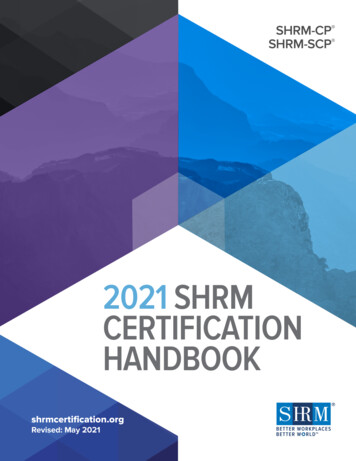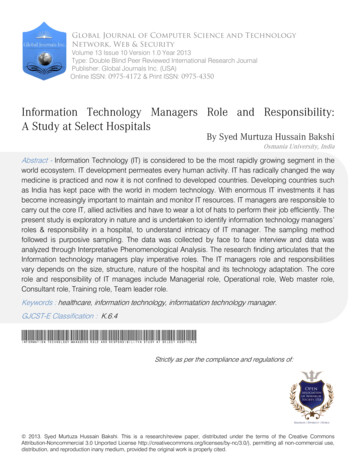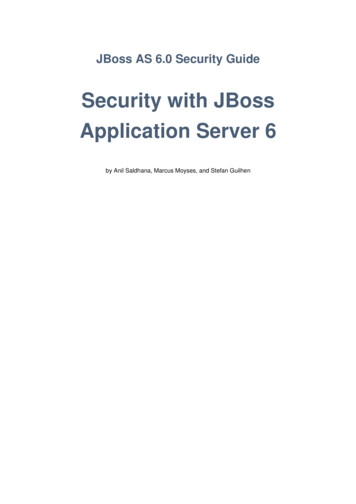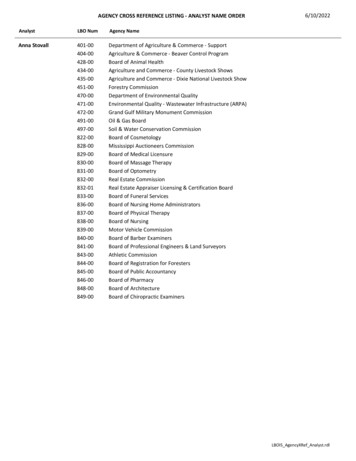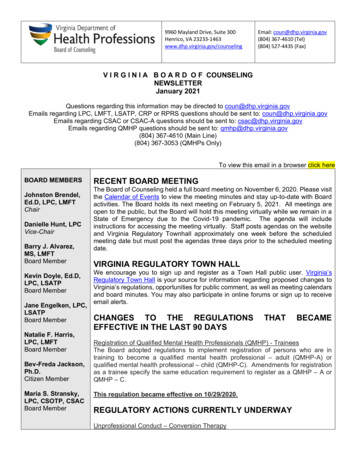
Transcription
The Board’s Role In Quality& Patient SafetyElie S Honore MD, MPH, MHAConversations on Governance December 05, 2021
The information in this slide deck is provided for noncommercial educational purposes only and is notintended, nor should it be used, as legal counsel. Thismaterial may not be used or reformulated for anycommercial purposes; neither shall it be published byany person or agency other than an officialorganizational unit of the Seventh-day Adventist Church, unless prior written authorization is obtainedfrom Loma Linda University Health. Subject to theforegoing terms, permission to copy or use these slidessolely for non-commercial education use is herebygranted upon inclusion of this notice. Use of all or anypart of this program constitutes acceptance of theseterms by the User.Pictures in this presentation are from Microsoft Clipart2
Session Objectives1. To Raise Urgent General Awareness about theissue of Quality and Patient Safety in ourInstitutions in general, our healthcareorganizations in particular2. To motivate All leaders attending, to develop andimplement an Annual Institutional Plan ofQuality Care and Safety (PS & QI forhealthcare)3. It is not our objective to cover the details or thefull content & processes involved in a QualityProgram
Quality & Patient Safety Tasks Overview1.2.3.4.5.6.7.8.Board/Hospital Quality & Patient Safety Comm.Annual Plan of Quality & Patient SafetyData Driven - Specific Metrics with periodicmeasurements -Constantly Analyze DataData-driven Decisions better outcomesAudit Compliance with Regulations/LawsWhere ‘Gaps’ emerge, use QI methods toimplement the needed changeReview/Updating Policies/Procedure ManualsAll Events with sig. harm are analyzed (RCA) –Lessons Learned ; Specific Action Plans
Board: Why?It’s all about: Creating a culture of“Continuous Quality Improvement”“Improving my work is my work”
QUALITY Quality happens when a HC system increases aperson’s likelihood of receiving desired health outcomes- consistent with Evidence-Based Medicine Quality (patient) definition: “They give me exactly thehelp I need and want exactly when I need and want it” Quality is the continuous, dependable, sustainedprocess to satisfy a patient’s needs
What is Quality?[“A Place where you want to be ”]1.No Needless Deaths2.No Needless Pain3.No Helplessness4.No Unwanted Waiting[Timeliness]5.No Waste[Efficiency]6.No ][Equity]
Reasons for a Q & PS Plan The Board and Management are guiding the hospitalinto the future. Just like the pilots of an airplane, theyneed to know where they’re taking the hospital, andHow to do itHow can you recruit, staff, physicians, donors andothers if your attitude is: “We don’t know where we are going. Just come workwith us, send us money, give us 100% of your skillsand other needed resources and when we figure outwhere we are, then we will tell you.”
TOP Reasons for a Q & PS Plan Mission – Vision –ValuesQuality is one of the best expressions of Love,and Compassion –An endeavour to serve with Dignity and Respect
Colossians 3: 17 & 23-24 17 Whatever you do in word or deed, do all in thename of the Lord Jesus, giving thanks throughHim to God the Father. 23 Whatever you do, do your work heartily, as forthe Lord rather than for men, 24 knowing thatfrom the Lord you will receive the reward of theinheritance. It is the Lord Christ whom you serveEnglish Standard Version
Board’s Role in Q & PSRevision Questions
Why Quality is a Board Responsibility Hospitals with good management are more likelyto: {Operations, Monitoring, Target Setting, HR} Be High-quality hospitals (p 0.01) [43% vs. 14%] One Std Dev increase in management score was associated with a 20% increase in being a high-quality hospital Have Higher Board performance( p 0.001) a) Attention to Quality [ Board Time ( 25%) spent on Quality inBoard Meetings] b) Effective use of Metrics [Monitoring established Q targets] Effective Hospital Board Governance positivelyimproves a hospital’s Quality performance!Tsai, Jha, Gawande, Huckman, Bloom and Sadun. “Hospital Board and Management Practices Are Strongly Relatedto Hospital Performance on Clinical Quality Metrics.” Health Affairs, 34 (8) (2015): 1304-1311.
Why Quality is a Board ResponsibilityClinical Outcomes are better in hospitals where: Board spends 25% of its time on quality and safety(p 0.0009) Board receives a quarterly formal quality measurementreport (p 0.005) High level of interaction occurs between the Board andmedical staff on quality metrics (p 0.02) Senior executive compensation based in part on qualityand safety performance (P 0.008) CEO identified as person with greatest impact on QI,especially when so identified by the Executive (p 0.01)Vaughn T, Koepke M, Kroch et. al. J of Patient Safety 2:2-9
Key Steps for Boards to EnhanceQuality/Patient Safety1.Document Board’s formal commitment to improvingQuality and Patient Safety vote Signed document2.Quality IS clearly reflected in the hospital’sMission/Strategy3.Board Vote the organization’s definition of “Quality”and Adopt a Quality methodology4.Establish a Board Quality and Patient SafetyCommittee to create Policies and Monitor (“Track”)progress in optimizing Quality
Ideal Board StructureConstituencyHospital teeAuditCommitteeMissionCommitteeQuality/Pt. SafetyCommittee
Quality vs. FinanceNo Board would be expected to govern withoutmeaningful financial data. The same is true forquality and patient safety data A structured accountability format: If quality measures are not met, corrective action istakenThis approach is common for financial performance,but somewhat unheard of for Quality
Quality vs. Finance“If hospitals had a Board Quality Committeethat functions like a Finance Committee, Wewould transform healthcare.”Peter Pronovost, M.D.
Suggested BoardQuality/Pt. Safety Committee MembershipChair: Member, Board of Trustees 2 Board Members with background in Quality Hospital CEO/CMO/CNO/CFO Hospital Quality Coordinator 2-3 staff (medical, nursing, quality facilitators, etc.) Consider 1-2 patient/family members
Board’s Role in Quality & PS Exactly the same concept as the Board’s role in Finance: Establish Policy and Monitor (“track”) progress inoptimizing Quality –tracked by a performancemeasurement dashboard Review QI Project performance of major QI projectsat least quarterly Help senior management focus their energy onchallenging areas
Board’s Role in Quality Ensure your HC Board has “Quality & Patient Safety” as atleast 25% of its agenda – “Q & PS” Board Committee Board must: Establish QI priorities and Monitor “Q and PS” status Establish a “Just Culture” (a Culture of Safety) Select a Quality Improvement Methodology Include Q/PS goals in your CEO’s Performance Evaluation Encourage CEO to communicate QI results to staff (telling“stories”)Tad-Y, D, Pierce RG, Pell JM, et al; “Leveraging a Redesigned Morbidity and Mortality Conference that Incorporates theClinical and Educational Missions of Improving Quality and Patient Safety”, Academic Medicine, April 2016
Board’s Role in Q/PS - Model MGH in mid 2000 had a Board retreat to analyzequality progress improvement - Result:1. New Mission Statement : with a safety focus,developing trust and boundary statements foremployees2. They created a new C-level (VP) position thatreported to the MGH CEO and the Physician practiceCEO. This sent the strong message that quality and safetyare important enough to act upon
MGH Quality Committee - Report to Board Each Board meeting review of your hospital’s qualityand safety status First item on the AgendaAllow for 25% of Board Agenda timeChair of the Quality Committee presents report: Synopsis of cases reviewed, findings and action plansOverview of performance scorecardHighlight key issues the QC is currently focused onSolicit feedback/answer questionsMake recommendations for policy changes
Quality & Patient SafetyCase #1
Institute for HealthCare Improvement A good example is the IHI’sTriple Aim:Patient Experience Health of the Population(Outcomes) Lower Per-capita Cost The three dimensions canserve as a framework toorganize the Board’s agenda
Annual Quality Plan 1- The Hospital “Q & PS” committee creates the AnnualQuality Plan (to be reviewed and approved by the Board) Annual Quality Plan Standard Format: - Metric goals met (graphs), - Discuss changes made; with continuing surveillance - Priority Metrics, opportunities for improvement- Specific Action Plans for each opportunity; withgoals, time frame, responsible person, and reportingschedule - Annual schedule of quarterly Q & PS reports fromdepartments staggered through each quarter
“Annual Plan”Performance Measurement Plan To facilitate frequent reviews of a hospital’s currentstatus with the Annual Quality Plan, many hospitalsuse what is known as a “Performance MeasurementPlan” (PMP) To facilitate visualization of an organizations manyQuality Metrics, instead of monthly reviewing a 50page document outlining all the parameters of the“Annual Quality Plan”, use a 2 to 3-page ExcelSpreadsheet to track current status
Hospital Performance MeasurementScorecard A Performance measurement is a system to achieve andvisualize your strategic plan The initial step is developing your 2-5 year plan You agree upon metrics to measure goals You measure where you currently are and notewhere to improve Then, you establish a Performance Management gridto monthly, quarterly, and yearly show your progressin meeting your goals
QM - Identifying Quality “Gaps” Hospital Quality and Patient Safety Committees can useexternal tools, such as the Joint Commission International’s“Navigator” tool to identify the Opportunities forImprovement (“Gaps”) in meeting standard policies andprocesses that have the potential to contribute to patientharm Existing programs use the results of the previous year’sAnnual Quality Program and any changed regulatorystandard to identify the “Gaps” to address in the comingyear
“Swiss Cheese” Model of Error
Why “Quality Improvement” (QI) vs.“Quality Assurance” (QA) Activities? Quality Assurance supportsbest outcome within systemdesignQA “Quality Improvement”transcends design to improveoutcomesQI
QI Change If an organization reviews its status and finds thatthey are not achieving their mission (a commitment toproviding increased value) the Board understands thatthe organization must “change”A system is “changed” by redesigning the systemimplementing change using “Quality Improvement”methodologies Method of Improvement (PDSA Cycles)LeanTo facilitate change, institutions use a “PerformanceMeasurement Plan” [PMP]
Lean “A3” QI Process A standardized approach to problem solving: For department-based or facility-wide problems –administrative or clinical (or both)A step-by-step direction to problem solving Uses process mapping, PDSA cyclesThe A3 provides a clear, concise, one pageoverviewIt can consolidate large amounts of information inan understandable format using visual displayAs the “default QI process, the A3 avoids wasted time indetermining how to approach a problem
LEAN A3 Protocol1.Reason for Action:VISION / AnalysisAIM4. Gap Analysis:What needs to Change2.Current State:Make a Flow Map of theexisting Process5.Solution Approach:Change Ideas8.Confirmed State:Sustain & Spread6.Rapid Experiments(many PDSA Cycles)Experience Change9.Insights:Lessons LearnedNext Steps7. Completion Plan:Sustain new processSpreadBaseline measurement3.Target (or Future) State:Map Ideal/Target StateMeasure
“Quality Improvement”visualized by an “A3” Basically, the Scientific Method: Measure the existing process(es) Analyze the steps in the process (processmapping) Conduct experiments changing the process (ManyPDSA Cycles) Measuring the results Analysis: accept (incorporate into your processes)or reject the piloted change
Hong Kong (Tsuen Wan) Adventist Hospital
Engaged Medical Staff
Medical Staff BylawsRules & Regulations
Engaged Medical StaffCase studies
Qualifications for Medical StaffMembership Valid License to practiceCurrent clinical competency including goodjudgmentEthical ConductCurrent Adequate Health Status Willingness to participate in tasks: committeesAcceptable Malpractice history and ProfessionalLiability Insurance
Board’s Role in& Patient Safety Recap
TASKS in Q I & P S �Data Driven Specific Metrics,under periodicmeasurements.23ConstantComparativeAnalysis of Data6Verification ofCompliancewith Reg/Laws9Q&PSCommitteeappointed withCharter107Review/Updating ofPolicies - IPSG)Decision takenfor betteroutcomes(Policies )All Events (Incidents)analyzed (RCA) –Lessons learned ;Specific ActionPlans Annual Plan ofQ&PS4SystematicReview of CareProcesses812Cycle of PS &ContinuousQualityImprovement
We recognize publily the contribution byDwight C Evans, M.D. to today’s presentation Physician,Endocrinologist, Loma Linda Professorof Internal Medicine, who through the years hasdevelopped a singular attachment for Quality &Patient Safety. He is also an Honorary AsssociateDirector,Health Ministries Department, GeneralConference of the Seventh-Day Adventist ChurchThank You
Effective Hospital Board Governance positively improves a hospital's Quality performance! Tsai, Jha, Gawande, Huckman, Bloom and Sadun. "Hospital Board and Management Practices Are Strongly Related to Hospital Performance on Clinical Quality Metrics." Health Affairs, 34 (8) (2015): 1304-1311.





